The minor pentatonic scale is a simple yet powerful tool in the music world.
It’s like a secret ingredient that can spice up your playing, helping you create catchy solos and unforgettable melodies.
With just five notes, it’s amazing how this scale can add so much flavor to music across genres from rock to blues, and beyond.
Whether you’re a guitarist, an aspiring music producer, or just someone who loves to explore the mechanics of music, the minor pentatonic scale opens up a world of possibilities.
That’s why, in today’s article, we’ll be breaking down:
- What makes the minor pentatonic scale special ✓
- Basic structure and notes in more detail ✓
- Learning the scale shapes ✓
- Memorizing the scale positions ✓
- Creating melodies and solos ✓
- Improvisation techniques & how one note can change everything ✓
- The minor pentatonic scale across the fretboard ✓
- Exploring the five positions & connecting scale shapes ✓
- The minor pentatonic scale vs the major pentatonic scale ✓
- Incorporating the blues scale ✓
- Scale patterns, scale degrees, creative techniques ✓
- Much more about minor pentatonic scales ✓
You’ll know everything about the minor pentatonic scale so you can manipulate the fretboard with ease and create solos that captivate listeners.
As well as improvise with confidence and swag.
Plus, be able to apply it across various musical settings in order to take your playing and music theory knowledge to new heights.
So, let’s dive in…
Table of Contents
Understanding the Minor Pentatonic Scale
The minor pentatonic scale is a five-note scale that’s essential for anyone interested in music, from beginners to pros. Let’s break down why this scale is so important and how to creatively use it. Just a quick note: while this article is catered to guitarists, the most valuable MIDI pack for music producers can be found at the bottom!
-
What Is the Minor Pentatonic Scale?

The minor pentatonic scale is a simplified version of the minor scale.
Unlike the full minor scale, which has seven notes, the minor pentatonic scale removes two notes; the second and sixth degrees.
Removing these two notes leaves us with a five-note scale that is much easier to play and memorize.
For instance:
- In the key of A minor 一 The full scale would be A, B, C, D, E, F, G.
- The A minor pentatonic scale 一 Just A, C, D, E, G.
The simplicity of this versatile scale makes it easier to learn and gives it that distinctive sound commonly used in genres like rock, blues, and pop.
Plus, its adaptability makes it so you can throw it over different chord progression variations and musical styles for intriguing results.
So, if you’re looking to create memorable solos and hooks, the minor pentatonic scales can certainly help.
Note
A famous song example of its use is found in “Stairway to Heaven” by Led Zeppelin, where Jimmy Page uses the A minor pentatonic scale to create that epic guitar solo.
-
Basic Structure and Notes

Understanding the basic structure of minor pentatonic scales involves recognizing its five-note sequence, which repeats across octaves.
The minor pentatonic scale is constructed by taking the 1st, 3rd, 4th, 5th, and 7th scale degrees of its parent scale (natural minor scale).
Basically, it skips the half steps that typically introduce tension within a scale.
For example, in the key of E minor, the E minor pentatonic scale consists of the notes:
- E (root)
- G (minor third)
- A (perfect fourth)
- B (perfect fifth)
- D (minor seventh)
These same notes form the backbone of countless unforgettable melodies and solos due to their cohesive sound.
Plus, each note within the scale can be great starting points for improvisation or songwriting, so it’s a super useful blueprint for when you’re looking to experiment.
-
Pro Tip: The Minor Pentatonic Scale vs Major Pentatonic Scale
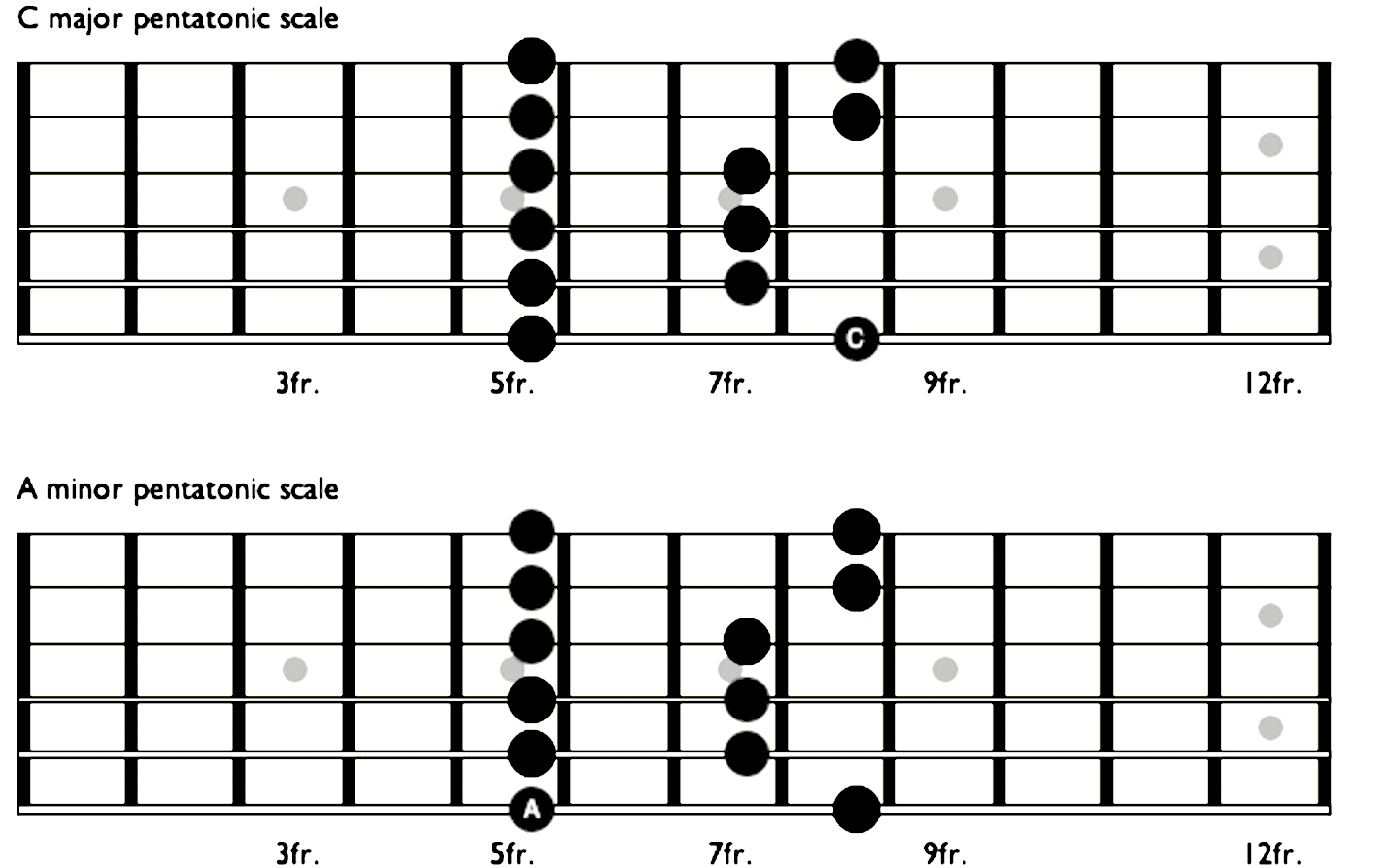
The minor pentatonic scale and the major pentatonic scale are two closely related sides of the same coin, each offering unique emotional textures to music.
Derived from the natural minor scale, the minor pentatonic skips the 2nd and 6th degrees.
This leaves us with a scale that’s ideal for evoking deeper, more introspective feelings.
The major pentatonic scale, which is based on the major scale, omits the 4th and 7th degrees 一 resulting in a brighter, more uplifting sound.
For example, the C minor pentatonic scale (notes: C, Eb, F, G, Bb) differs significantly in mood from the C major pentatonic scale (notes: C, D, E, G, A).
- The C minor pentatonic scale, with its minor third (Eb) and minor seventh (Bb), gives off a sadder, more reflective tone.
- The C major pentatonic scale features the major third (E) and avoids the tritone interval entirely by excluding the F and B notes.
So, naturally, it leans towards happier, more resolved melodies.
It’s all about choosing what you want the mood of your track to be and deciding between the minor (sad) and major pentatonic scale (brighter) accordingly.
-
Learning the Scale Shapes

The minor pentatonic scale can be visualized through five distinct shapes or patterns across the guitar fretboard.
Each scale shape links together to cover the instrument’s entire range.
These shapes are key for guitar players as they allow for fluid movement and improvisation across different keys without changing the fingering pattern.
Starting with Shape 1, often learned in the same key of A minor at the 5th fret, you can immediately begin creating unique music with just a few notes, utilizing the scale’s:
- Root note (A)
- Minor third (C)
- Perfect fourth (D)
- Perfect fifth (E)
- Minor seventh (G)
Advancing through Shapes 2 to 5 requires practice but opens up the whole fretboard 一 allowing for more expressive and varied play.
For example, Shape 2 in the A minor pentatonic scale starts at the 8th fret, which introduces a new set of finger positions and extends the range of available notes.
This progression of shapes ensures that no matter where you are on the fretboard, you can access the powerful and impactful sounds of the minor scales pentatonic.
It’s all about reeling people in with something they feel in their soul.
Creative Uses of the Minor Pentatonic Scale
Playing around with minor pentatonic scales is not just for practice 一 it can help you unleash your creativity. From coming up with catchy melodies to improvising solos, the possibilities are endless with this type of minor scale.
-
Creating Melodies and Solos

Creating melodies and solos with minor pentatonic scales can tap into their inherent musicality and the emotional depth of its notes.
By starting with simple motifs or phrases within a single scale shape, and then expanding them across the whole fretboard through different positions, you can discover rich, compelling musical ideas.
For instance, you can try taking a basic lick that uses the same notes A (first note), C, and E from the first position of the A minor pentatonic scale.
Then, repeating or modifying this motif in higher octaves or within different positions.
This will introduce variation and complexity to your solos.
Try experimenting with techniques like:
- Bends
- Vibrato
- Slides
But remember to focus on how they can highlight the unique character of each note within the pentatonic scale.
For example, bending the note G up to A in the first shape adds a sense of resolution and emphasis 一 often used to punctuate phrases or solos.
Incorporating these techniques not only enhances the emotional expression of your playing but also personalizes your sound.
Much like B.B. King’s distinctive, vocal-like solos that often focus on expressive bends and vibrato on key notes of the minor pentatonic scale.
-
Chord Progressions & Scale Integration
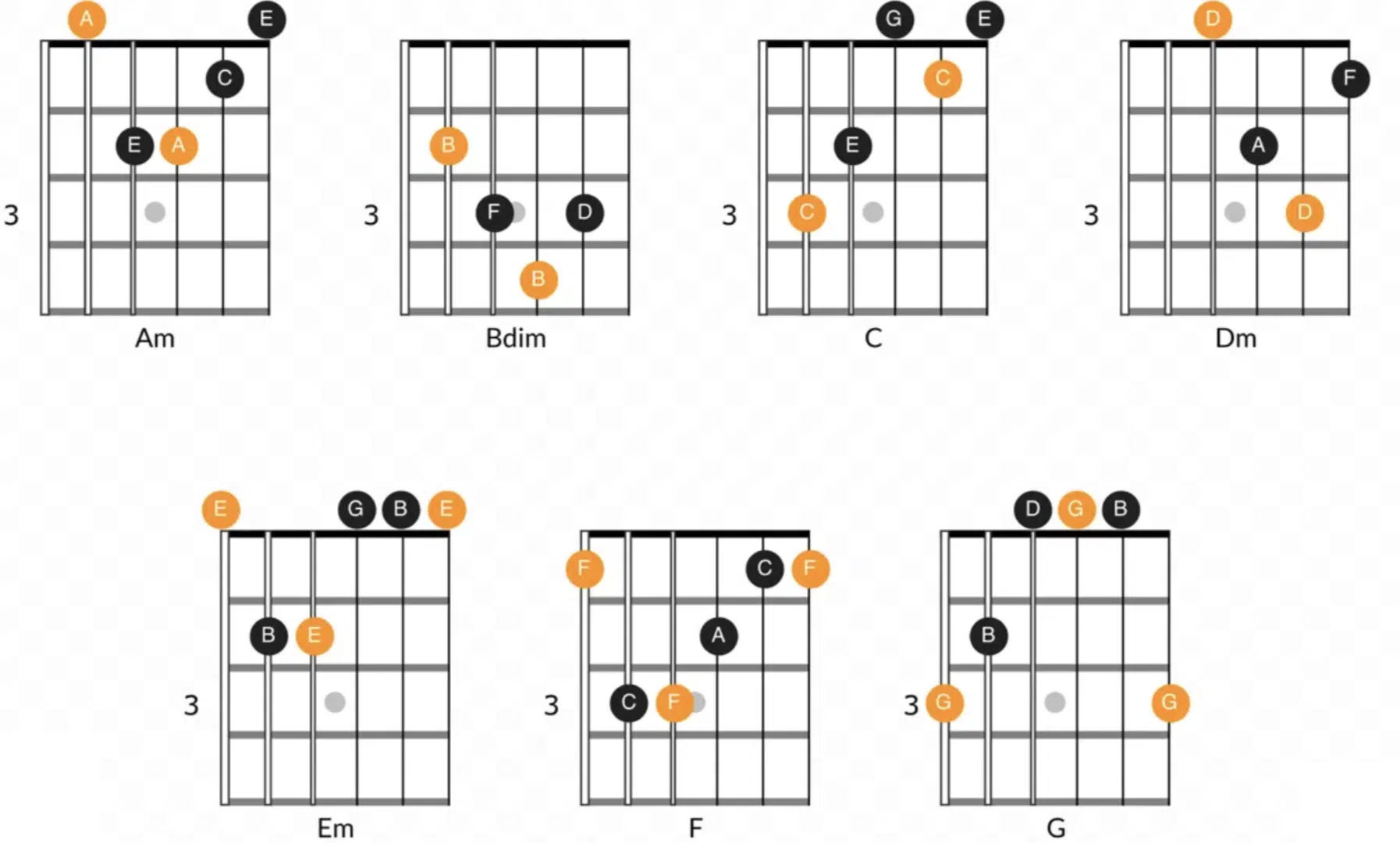
Integrating the minor pentatonic scale with a captivating chord progression can add some serious depth to your songs.
All the notes of this scale can outline chord tones, creating a cohesive sound.
For example, over an Am chord, playing notes from the A minor pentatonic scale highlights the harmony while allowing for melodic exploration.
Understanding the relationship between the scale and underlying chords/chord progression opens up opportunities for creating:
- Basslines
- Riffs
- Solos
All of which should complement the harmonic structure of a song perfectly.
Practice playing the same scale over different chord progressions to see how it can fit into new and exciting musical contexts.
-
Improvisation Techniques

Playing around with the minor pentatonic scale (like the B minor pentatonic scale) is not just about repeating the same notes in sequence but using them creatively to express a certain mood or story.
A great way to practice improvisation is by starting with a backing track in a specific key and then experimenting with the notes of the corresponding minor pentatonic scale.
For example, if the track is in the key of G minor, use the G minor pentatonic scale (notes: G, Bb, C, D, F) to improvise.
Begin with pretty straightforward phrases, focusing on rhythm and phrasing…
Then, gradually introduce more complex ideas and techniques like string bending with your index finger and sliding between two notes.
Another effective improvisation technique involves call and response.
This is where you play a phrase (the call) and follow it with a complementary phrase (the response) 一 mimicking a conversation.
Mastering this approach requires a deep familiarity with the minor pentatonic positions and shapes, that’s a given.
However, it also requires an attentive ear to dynamics and the flow of the music you’re improvising over, so make sure to always practice!
-
Beyond the Basic Minor Pentatonic Scale Shapes
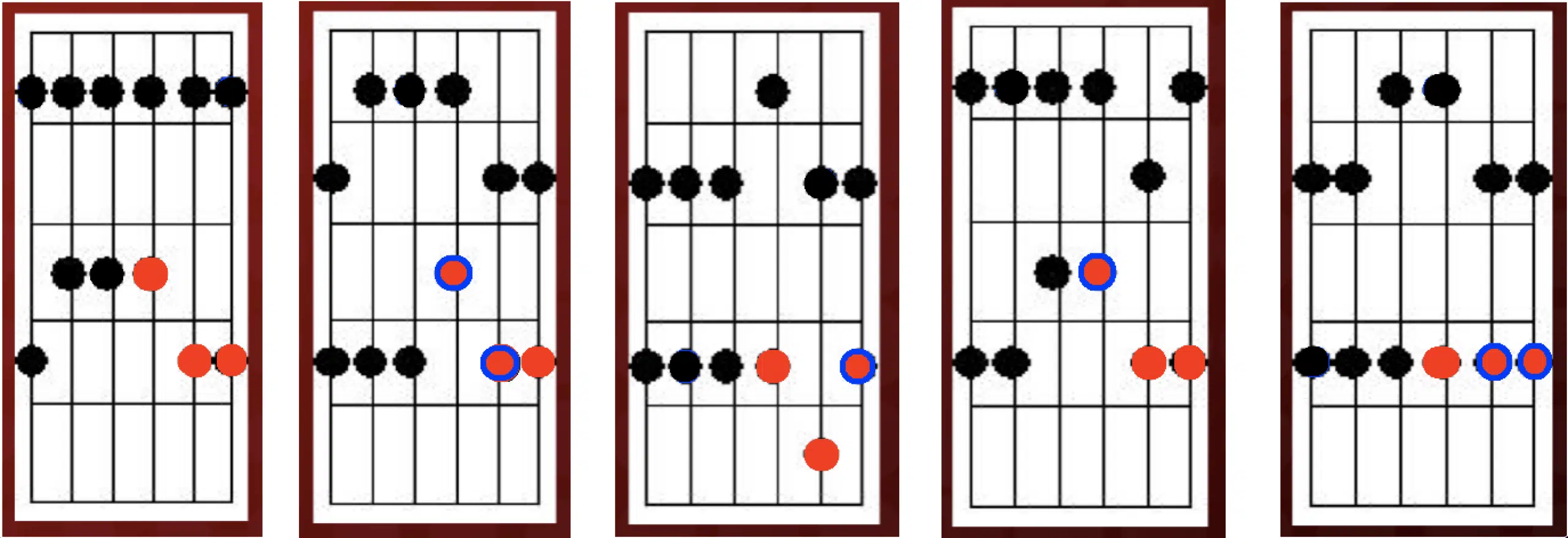
After mastering the basic minor pentatonic shapes, it’s super important to expand your toolkit with advanced techniques that can enhance your expression.
String bending and vibrato are two such techniques (we just talked about) that can transform simple scale notes into emotional musical phrases.
For example, when playing the A minor pentatonic scale, try bending the note G up to an A to mimic the vocal-like quality of blues and rock music that pros who play lead guitar love.
As guitar players, this not only tests your pitch accuracy but also adds a layer of expressiveness to your playing.
Vibrato, on the other hand, involves slightly oscillating the pitch of a note, achieved by quickly and repeatedly bending the string up and down.
Applying vibrato to the E note in the same A minor pentatonic scale can create a sustained, singing tone 一 adding emotional depth to your guitar solos.
These techniques can seriously make your notes speak to your audience.
NOTE: Practicing them in different scale shapes and positions helps integrate them into your playing, making your solos more dynamic and expressive.
The Minor Pentatonic Scale Across the Fretboard
Understanding how to maneuver the minor pentatonic scale across the entire fretboard unlocks new possibilities for creativity and improvisation. It won’t only help your music theory knowledge and guitar playing with this minor scale but also help you discover awesome new techniques.
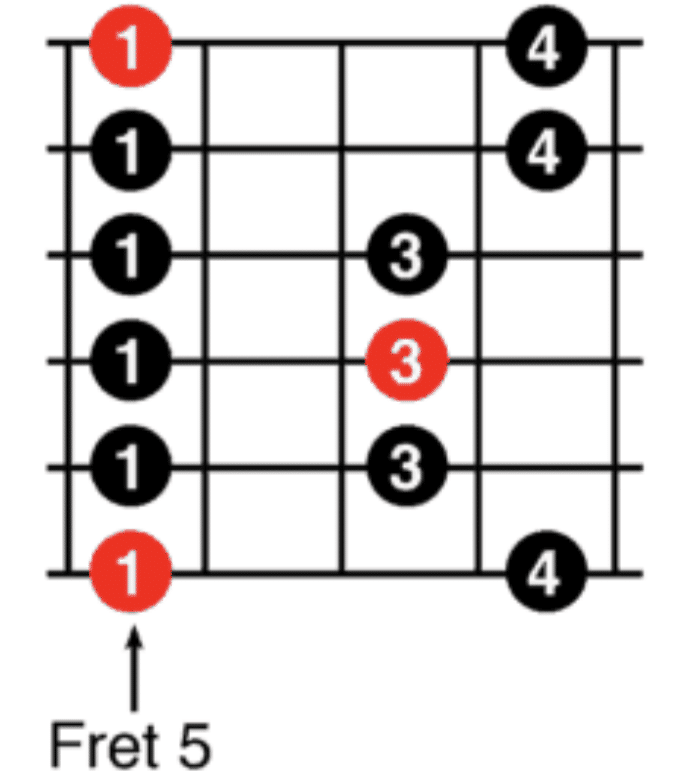
The 5th fret is a common starting point for learning the A minor pentatonic scale, as it’s a comfortable scale position for most guitarists.
Here, you can easily access the scale’s root note on the 6th string, which provides a solid foundation for exploring the scale.
To practice, begin by playing the scale from the low E string to the high E string, focusing on the clarity of each note.
As you become more confident, challenge yourself to incorporate the string bending and vibrato techniques discussed earlier (particularly on the notes D and G) to add expressiveness.
Expanding beyond the 5th fret involves learning to identify the root notes and scale patterns in other positions across the fretboard.
This skill is vital for versatility and helps you play the minor pentatonic scale in any musical context you can dream up.
Practice by locating the root note, A, in different octaves and positions, then build the scale from those starting points.
This approach not only improves your fretboard navigation but also enhances your understanding of the scale’s structure.
-
Exploring the Five Positions
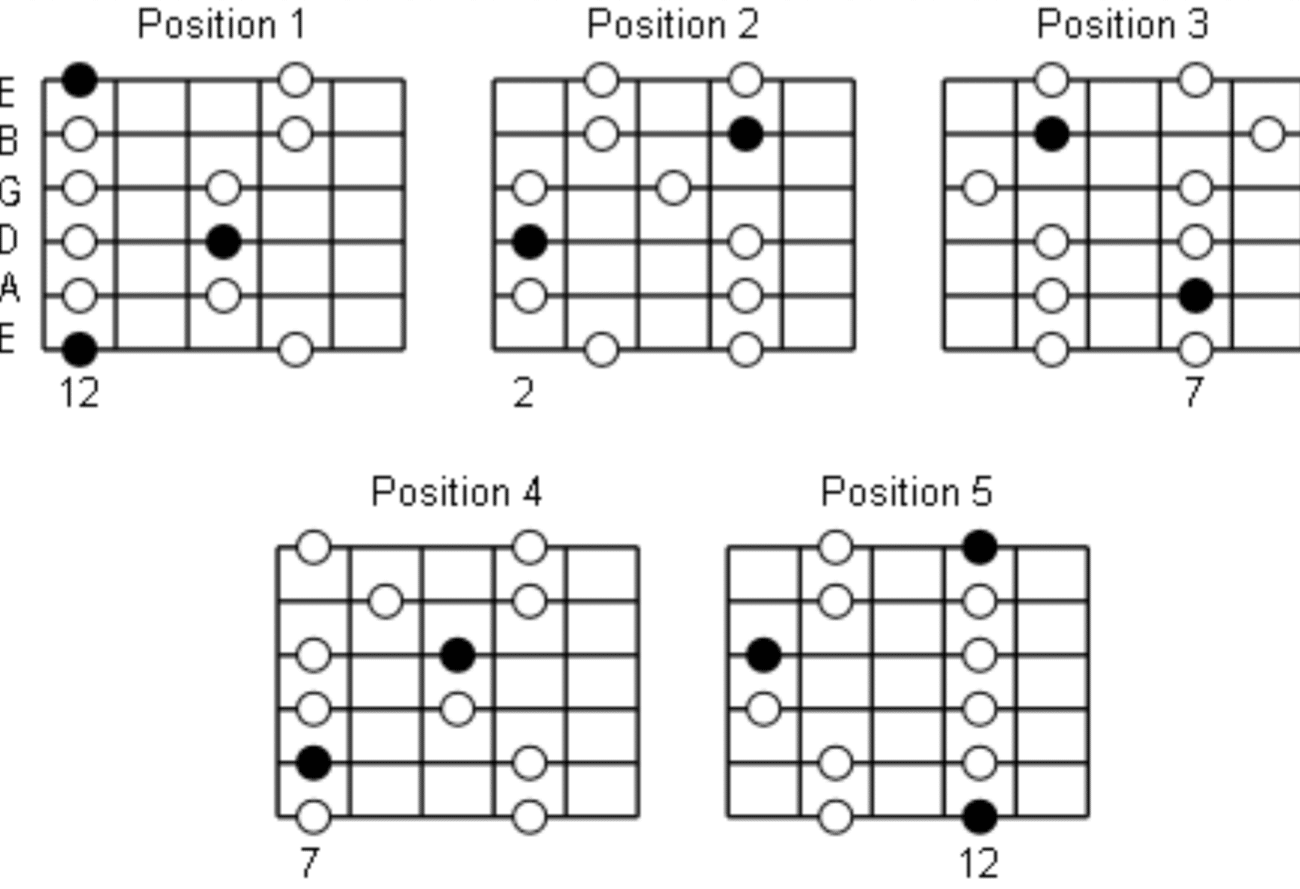
E minor pentatonic scale
The minor pentatonic scale can be played in not just one position or two positions, but five main positions on the fretboard 一 each offering unique melodic opportunities.
The first position, starting at the 5th fret, is where most new songwriters start their minor pentatonic scales journey.
However, unlike the first position, moving to the second position (which begins at the 8th fret with the note C on the 6th string) brings new exploration opportunities to the table.
In the second position, the scale extends higher in pitch, which is ideal for lead guitar solos and melodies that reach upward.
The third position starts at the 10th fret, with the root note A on the 5th string.
This scale position is particularly useful for playing in the middle range of the guitar, offering a balance between low and high tones.
The fourth position and fifth position continue this pattern, progressively covering the entire fretboard.
Each scale position has its characteristic feel and sound, influenced by the specific notes and their arrangement under your fingers.

Practicing these positions involves more than just playing the notes in order; it’s about making music with them that people really connect to.
Create short melodies or riffs in each position, paying attention to how the position’s layout influences your musical ideas.
This will not only solidify your minor scale knowledge but also inspire new ways to express yourself with minor pentatonic scales in general.
-
Minor Pentatonic vs Blues Scale

The blues scale, essentially the minor pentatonic scale with an added flattened fifth, introduces a grittier, more tension-filled sound to your playing.
In A minor, this means adding the note Eb between D and E.
Incorporating the Eb into your A minor pentatonic scale (notes: A, C, D, Eb, E, G) adds a distinctive bluesy feel.
You’ll hear this a lot in the solos of guitar legends like B.B. King and Eric Clapton.
This “blue note” introduces a sense of dissonance when played against traditional chords, creating a tension that’s resolved when moving to the next note in the scale.
For example, playing a lick that includes this Eb over an A minor chord can create a classic blues sound with a twist.
It just shows the minor pentatonic scales versatility beyond straightforward rock music or pop melodies.
When practicing the blues scale, focus on the placement and resolution of the Eb.
Try incorporating it into licks that start or end on the root note, A, to emphasize its color within the context of the scale.
A common technique is to bend the D up to the Eb and then release back to D, or slide from Eb to E 一 using the blue note to add even more complexity to your playing.
Pro Tip
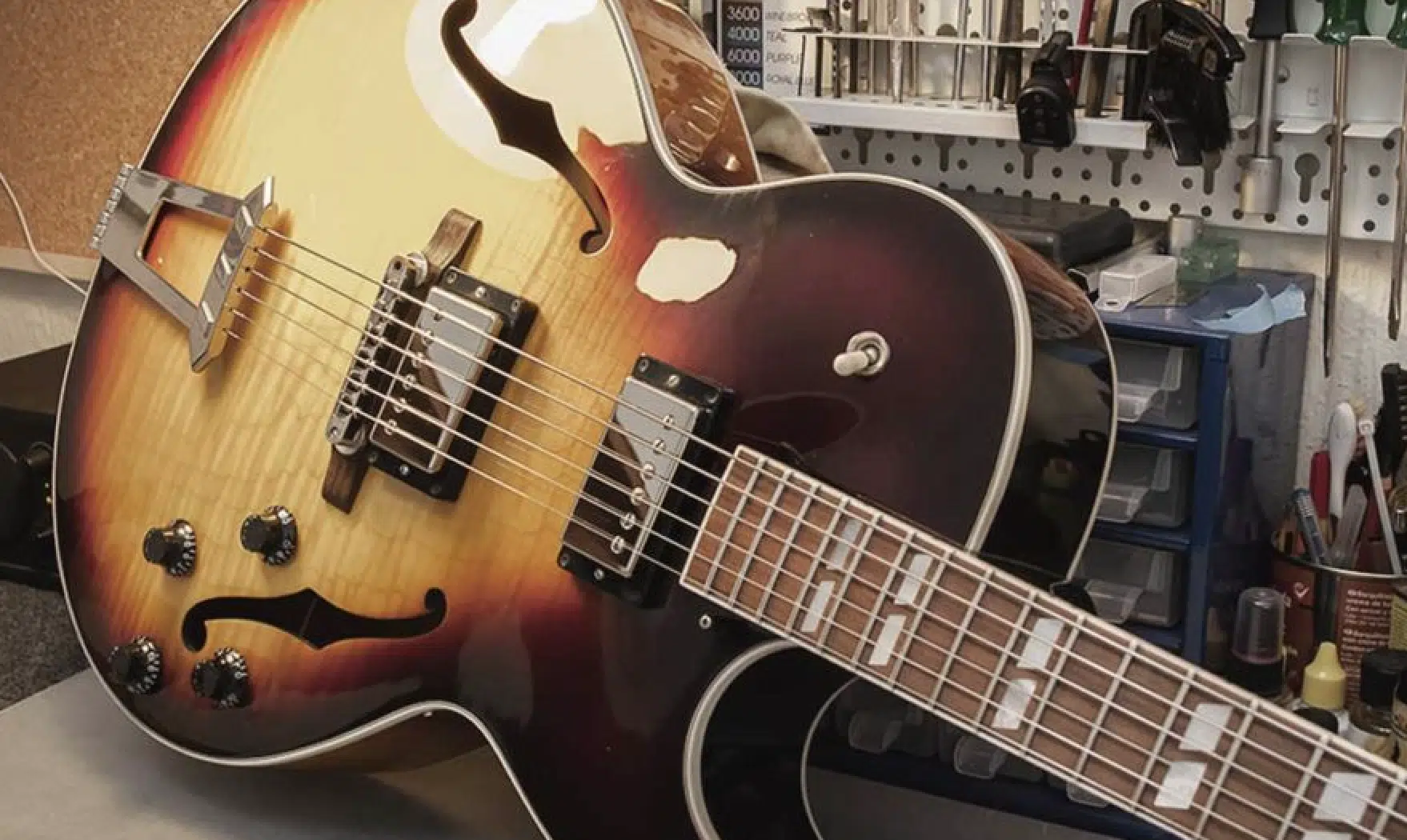
As you become more familiar with including the blue note in your lead guitar solos, make sure to experiment with its application across different positions of the minor pentatonic scale on the fretboard.
This not only enhances your composition skills but also deepens your understanding of how blues and rock musicians create their signature sounds.
Playing along with backing tracks in various keys can help solidify your grasp of the blues scale and help you use it creatively in your music.
-
Scale Patterns and Licks

Beyond learning each scale shape and position, mastering the minor pentatonic scale involves developing a routine of licks and patterns that you can always draw from.
These musical phrases are the building blocks of memorable solos and catchy riffs.
For instance, a classic lick in the A minor pentatonic scale involves:
- Starting on the high E (the 5th degree)
- Bending up to G (the 7th degree)
- Descending through the scale to land on A (the root note)
This pattern can be varied rhythmically and melodically to fit different vibes.
To expand your vocabulary, practice combining scale degrees in unexpected ways.
This could include methods like jumping from the root note to the 7th degree and back or incorporating slides from one scale position to another.
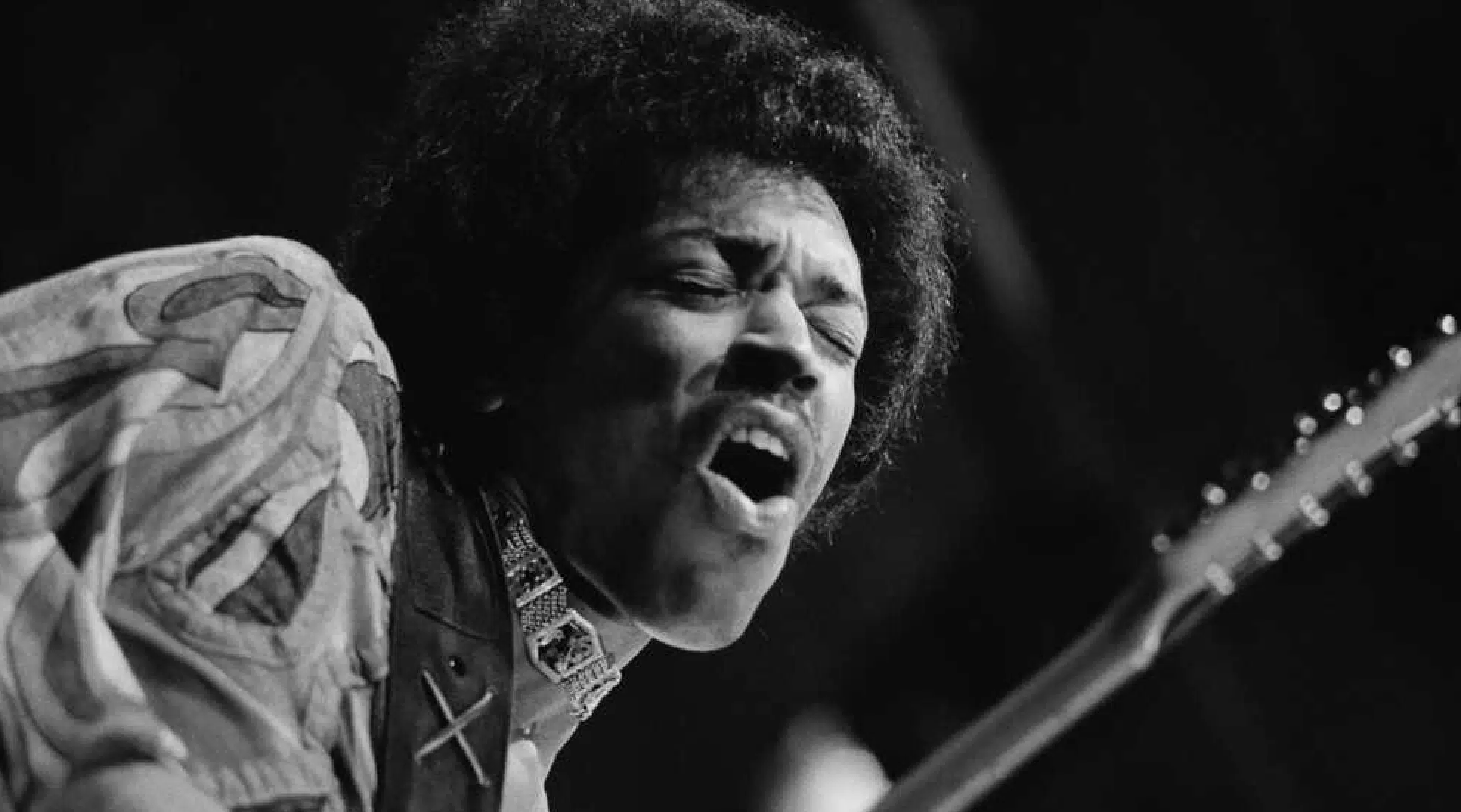
Listening to and learning solos from famous songs that utilize the G minor pentatonic scale extensively, such as “La Grange” by ZZ Top or “Purple Haze” by Jimi Hendrix, can provide inspiration and insight into how to use the same scale creatively.
It’s essentially like a reference track.
NOTE: Try recording yourself playing these licks and patterns so you can critically listen back and refine your technique and style.
It will help you master minor pentatonic scales much faster.
Bonus: The Unison Minor Pentatonic (Blues) Advanced Scales MIDI Collection
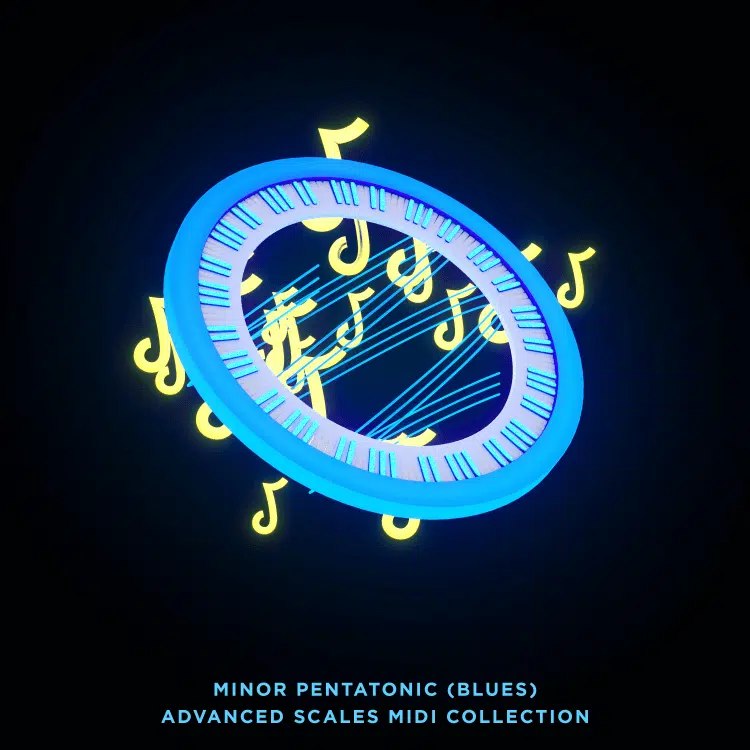
Since we’re talking about mastering and manipulating minor pentatonic scale, we’ve got to mention the absolute best resource for doing so:
The Unison Minor Pentatonic (Blues) Advanced MIDI Collection.
This pack is like a treasure chest for music producers, packed with over 1,100 MIDI files of scales, chords, progressions, and melodies all based on the minor pentatonic scale.
It’s the backbone of countless hit songs across genres, from blues to rock, and even pop hits like Ed Sheeran’s “Shape of You.”
This collection isn’t just a random set of MIDI files.
It’s the result of a tireless look into the biggest Minor Pentatonic tracks out there, studying what makes them tick and then bottling it up for you to create hit tracks.
Whether you’re starting a track from scratch or looking for that perfect melody to complete your song, these MIDI files are ready to use and fully customizable.
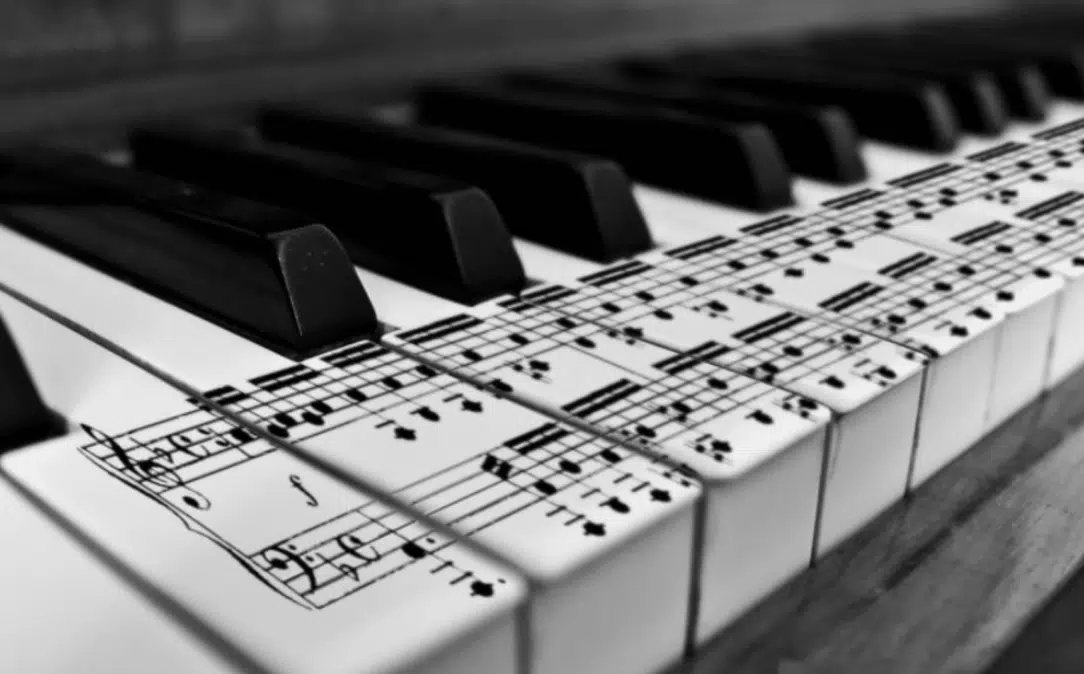
You can adjust the notes to fit your style or use them as they are.
This means you can skip spending years learning music theory and get straight to making music that stands out.
For anyone serious about mastering the minor pentatonic scale and using it to create legendary music, this pack is invaluable.
Download This Game-changing MIDI Pack Now!
The Minor Pentatonic Scale: Final Thoughts

The minor pentatonic scale, as you now know, can help you open doors to deep emotional expression and inventive creativity.
It simplifies the process of composing melodies and working on solos 一 making it an essential scale for musicians across genres.
When manipulated in a unique way, the minor pentatonic scale can elevate your music 一 giving it that distinctive edge and making improvisation feel like second nature.
So, go practice, explore, and try out new, exciting techniques.
With patience and persistence, you can unlock its full potential and create music that resonates, inspires, and stands out like a professional.
Until next time…







Leave a Reply
You must belogged in to post a comment.